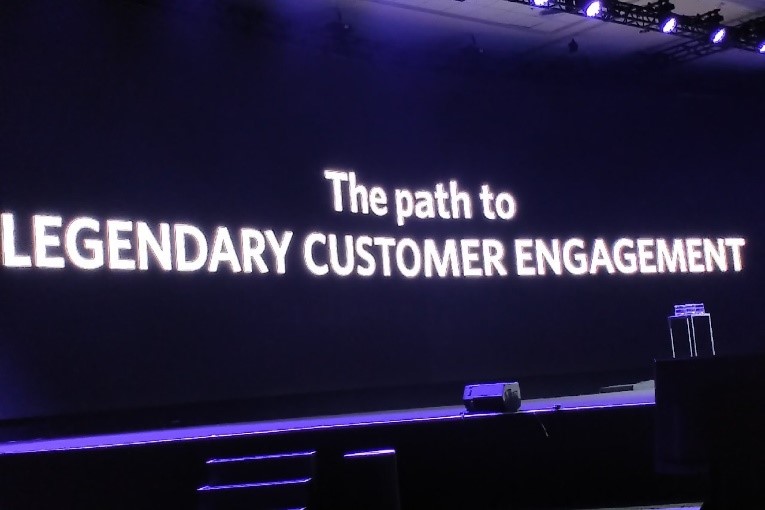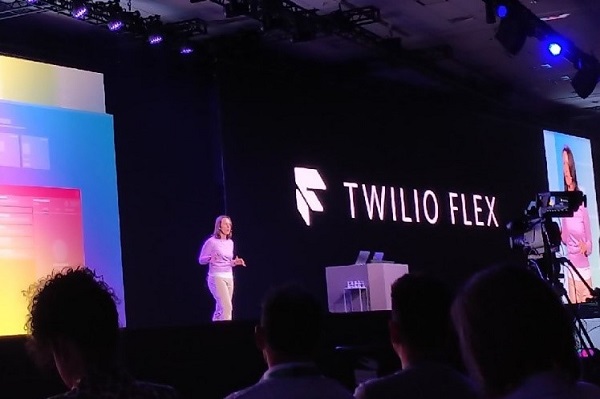By all accounts, Twilio’s recent Signal event was a validation that the company must be doing a lot of things right. Using a scorched-earth approach for media saturation, San Francisco was “its” town for a few days, Genesys and all comers be damned. It spent big to occupy the oversized Moscone Center, a big step up from the Bill Graham Auditorium where it convened last year’s event. If you were in town and didn’t know Twilio before Signal 2019, you sure did afterwards.
The conference didn’t disappoint. Sometimes hype is just hype, but clearly Twilio has reached enough critical mass that nobody in the communications space can ignore it any longer — even if you don’t really understand its business. By the numbers, here’s the picture CEO Jeff Lawson paints:
- 6 million developers on the Twilio platform
- 160,000 companies using its APIs
- 125,000 production releases in 2019
- 4,000 attendees at Signal 19, well up from last year
However you choose to interpret those numbers, they’re big, and this company is innovating at an incredible pace. Notable announcements included Conversations, Media Streams, SendGrid Email Validation API, Autopilot, Verified by Twilio, and Narrowband IoT Network (see related No Jitter coverage
here and
here).
Reflecting all of this is its stock price, which is up more than 70% from this time last year. Based on Twilio’s
latest quarterly filing, revenues have been growing at a 50%+ annual rate since 2015, and are currently trending towards the $1 billion mark by year-end. Twilio isn’t profitable yet, but if the metrics cited above continue growing, it’s reasonable to expect that it’ll be in the black soon.
When you hear people say that Twilio is “killing it,” now you know why. There’s more to the story, though, and I’m going to touch on two takeaways here that will be of most relevance to No Jitter readers.
Takeaway #1 — Papa Vic, aka Lawson the Legend
Within a minute of Lawson taking the stage, it’s clear that his passion is intense but purposeful, and that he’s a great communicator. These qualities elevate tech leaders beyond being pitchmen, and Lawson seems to have that in spades. Sure, there’s a lot of Kool-Aid here, and developers are an excitable crowd, but he has a knack for getting people to relate to all this mile-a-minute technology on a human level. That’s when you start making an emotional connection to the technology, and all of a sudden Twilio’s vision starts to make more sense.
He did this by going old school, talking at length about his grandfather — Papa Vic, aka Lawson the Legend, who sold paint supplies to independent hardware stores in Detroit. He loved his customers and they loved him — enough that he kept working til he was 97. Over that time, he built up an unbreakable bond of trust, simply because he was in regular contact with customers, listening to them, and from that, he always knew what they needed. (I could relate to Papa Vic, as his was basically my grandfather’s story, too… except he owned a family hardware store rather than being on the supply side.)
Today we call this type of service as removing friction and being customer-centric, but Papa Vic was just serving customers the old-fashioned way, in person with a personal touch. Building on his grandfather’s legacy, Lawson preaches a desire to bring those values and experiences forward in today’s environment. At Signal, he brought these concepts into the 21st century by talking about how APIs can create more personalized service and “legendary customer engagement at scale.”
That is, you don’t have to make every customer interaction legendary, but you build a reputation for legendary service by being consistent and doing all the little things right. As he said, “you gotta show up,” which is exactly what Papa Vic did day in and day out. The best way to know what customers really want is to be present and to listen.
Mapping that to Twilio, Lawson’s view is that a big part of showing up is using the channels that customers use. If they need voice, use voice. If it’s text, use messaging. If it’s mobile, use SMS. To do this at scale, you need a platform to support all these modes seamlessly so that agents can personalize interactions based on each customer’s preferences.
He never used the term “omnichannel” during his talk, but that’s how every contact center vendor would describe all of this. This is where things get more subtle, since Twilio doesn’t position itself as a direct competitor to these players. In fact, Lawson never specified that he’s talking about Flex here, which is purpose-built for contact center applications. Flex is just one of Twilio’s many API-driven, customer engagement-related offerings for developers’ use. I’ll touch more on Flex in the next takeaway, but this idea that purpose-built contact centers aren’t the only way for businesses to be customer-centric is important.
Takeaway #2 — Flex Is Flex, and That’s Good
Since Twilio falls primarily into the communications platform-as-a-service (CPaaS) bucket, its offerings don’t figure much in conversations around UC or collaboration. Along with being developer-centric, it’s challenging for collaboration analysts to slot Twilio into our coverage. While most collaboration players have some degree of CPaaS capability, it’s usually an add-on via acquisition, with the latest example being
8x8’s pickup of Wavecell.
Twilio, on the other hand, is a CPaaS pure play, much like how Genesys, Talkdesk, and Five9 are contact center pure plays. As contact centers and UC become further entwined with integrated cloud offerings, contact centers are becoming part of the collaboration landscape, and from there, Flex provides a relatable hook for our strain of analysts to follow Twilio. Since Twilio isn’t following the well-worn path of contact center vendors, a few things about Flex are worth noting.
First, we turn to an update on Flex from Jessica Popp, head of engineering at Twilio. After its splashy debut at Enterprise Connect 2018, Flex has taken some time getting to market. While Twilio touts name-brand customers such as Lyft, Shopify, and U-Haul, it hasn’t said much about Flex’s broader market take-up. Flex may not turn out to be the contact center giant killer that some fear and others cheer for, but it helps to at least understand what Twilio is trying to do and the value it brings to the ever-changing world of customer care.
One of Popp’s key messages was that contact centers generally aren’t built for continuous improvement. Once the platform is deployed, those are the tools you use. That’s an over-simplification, but in my ongoing research, I regularly hear how customers migrate to CCaaS because making changes or adding features with legacy systems was too difficult. Twilio doesn’t offer Flex as a complete contact center replacement, but this problem set plays nicely into a developer-centric model.
Twilio’s core approach to open APIs and programmable communications allows developers — or contact center managers responsible for technology — to make incremental improvements easily and quickly. When scaled up to a large customer base, the impact can be substantial, and that makes for an attractive ROI. Twilio cited Lyft as a success story; for a company dealing with millions of customer interactions, saving just one second from a customer interaction adds up quickly. Twilio didn’t show tangible benefits for Lyft, but the logic is sound, and by leveraging the cloud to hit singles instead of home runs, there’s plenty of room in the market for Flex.
Related to the continuous improvement idea, while Flex may still be finding its legs, the platform by nature will always be evolving. Of course, the same applies to other contact center platforms, as providers all try to adapt to the latest wrinkles such as AI, analytics, chatbots, and intelligent routing. With six million developers to draw from, Twilio should be able to keep pace, and so long as Flex stays true to the continuous improvement mantra, I’d say that this offering is aptly named.
It’s important to reiterate that Flex isn’t gunning to displace the incumbents in this space, and it’s pretty clear Twilio developers don’t have the voice pedigree to take on the heavy workload of telephony, which still drives most contact center interactions. However, Twilio seems well-positioned for where contact centers need to be headed, namely digital channels. Messaging is Twilio’s sweet spot, and being a digital channel, this plays well for contact centers trying to move along the digital transformation path.
Companies with a strong digital DNA will have people in roles like chief digital officer or head of developers, and for them, the Flex value proposition will be clear. They understand the importance of customer experience — like Papa Vic — and are more willing to invest in technologies that improve customer experience instead of just looking at improving operational efficiency. That’s why Twilio does well with companies like Lyft, and as digital natives come to shape tomorrow’s companies, where Flex’s growth will come from shouldn’t be a mystery.
Jon is writing on behalf of BCStrategies, an industry resource for enterprises, vendors, system integrators, and anyone interested in the growing business communications arena. A supplier of objective information on business communications, BCStrategies is supported by an alliance of leading communication industry advisors, analysts, and consultants who have worked in the various segments of the dynamic business communications market.












